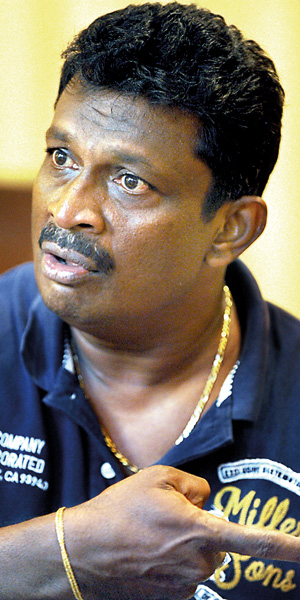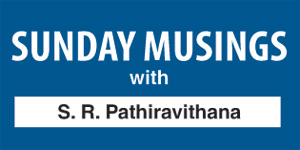This is why the Lankan fast bowling sucks
View(s):It looks so long ago and even may be so. It was a different era of cricket; way back in 1984 young fast bowler Champaka Ramanayake had just moved to Colombo after playing for Richmond College and managed to get a place in the Tamil Union Division II side. As for him, the first game went without much incident, but he held on his place with a wicket or two, but the next game was the crunch one against SSC. Even if it was a division II game, it was an important game of high intensity and also well scrutinised. In this game, young Ramanayake bagged a five in the first innings in front of the entire Tamil Union hierarchy. End of that game the Club’s cricket convener, S. Skandakumar, told the young lad that he would be playing the division one match scheduled for that end of that week and for Ramanayake it was the first step of an association with the club that lasted for over a decade, if I am right.

Champaka Ramanayake - Pic by Amila Gamage
Yet, the inner glow of that story was not Ramanayake playing his first game for the Tamil Union, but a structure that prevailed in cricket in Sri Lanka that was fool proof. Each club had its own nursery system where even a school leaver could fit into the system and be involved with the game till the club division one team was ready to accommodate him. Reciprocally, even an experienced player who was going through a slump could go down and play in a lower division still under the scrutiny of the club hierarchy and come back once the necessary repairs were done.
Besides, in the same club there was this division III side where all the over the hills stalwarts played the game also along with some young school leavers who did the bulk of the bowling and fielding, but in return were enriched with an experience the biggest Sports University could not provide even at a hefty fee.
Now all those systems are done away with – eaten by a structure that opted for a system that has bartered quantity to quality and left the current national king makers like Champaka Ramanayake to rue the past. Ramanayake, the national fast bowling coach, is faced with an unenviable task. He has been entrusted with the task of sustaining the present bunch of fast bowlers. While doing so he also has to work along with the national fast bowling academy so that a stream of young fast bowlers in the Lankan cupboard keeps entering the system. However, the most challenging task at hand for Ramanayake is that the entire gamut of fast bowlers should keep performing at a certain level that keeps on par with the International requirements — a task that he feels that the system also has to keep in line with and enable him to sustain his efforts.
We asked him about a bowler like Shaminda Eranga — one of the fast bowlers among the younger brood, who had an explosive entry into international cricket by bagging the then Australian captain Rickey Ponting’s wicket in successive innings, but who seems to have somewhat lost his initial aggression.
We also asked him whether a bowler outthinking a batsman is more important than sheer speed and aggression. Ramanayake explained: “Of course Eranga is one of the best new ball exponents that we possess, but, of late, his progress has been hampered by a string of injuries. However, I also believe that the major quality of a bowler should be his ability to outthink the batsman and beat him at his own game. In recent years two bowlers that we had in that category were Lasith Malinga and Nuwan Kulasekera. Especially Malinga when I discovered him as a 17-year-old raw hand, one quality ingredient that he possessed was his confidence. So with his awkward action and speed mingled with confidence, at once he became a bowler that was talked about in the international circuit. Later on with the variations that he developed, he became a world class bowler. But he always possessed that X-factor to outthink the batsman — and so did Kulasekera. Even if the batsman hits them for a boundary, they have the ability to come back and bowl a better ball in the very next delivery.”
The next question was why Sri Lanka was short of bowlers who could bowl consistently at 140kms and over. The national fast bowling coach’s reply was: “It all depends upon the Lankan genetics and we are not built in our stature to reach speeds of 140 and above. Yes, we do have some bowlers like Dushmantha Chameera and Nuwan Pradeep who can reach those speeds without much effort, but they have to learn the art of bowling at international stars and surviving. At the same time I firmly believe if you can reach speeds of 135+ and do a few things with the seam and length and bowl in the right areas, you can trouble a lot of international batsmen. It’s a case of the bowler being smarter than the batsman and staying a step ahead of him. For instance, the former Australian fast bowler Glen McGrath bowled in the mid-130s, but, he was a very smart bowler who had the knack of staying ahead of the batsman who is facing up to him.”
 He said the biggest bane in the local structure is the local club cricket system, where one hardly gets a track that is suited for fast bowlers. He said a study conducted by Sri Lanka Cricket coaching unit had found out that a fast bowler had averaged only 9.1 overs an inning during the past few years. Lamenting the situation, he asked how they could come to international level and bowl thirty overs in an inning. They would break down. This anomaly has been pointed out to the hierarchy on many occasions, but, pressure from the stakeholders has prevented the system from adopting suitable changes. He said they would be satisfied with at least 50-50 wickets where both batsmen and bowlers would have to work hard for results.
He said the biggest bane in the local structure is the local club cricket system, where one hardly gets a track that is suited for fast bowlers. He said a study conducted by Sri Lanka Cricket coaching unit had found out that a fast bowler had averaged only 9.1 overs an inning during the past few years. Lamenting the situation, he asked how they could come to international level and bowl thirty overs in an inning. They would break down. This anomaly has been pointed out to the hierarchy on many occasions, but, pressure from the stakeholders has prevented the system from adopting suitable changes. He said they would be satisfied with at least 50-50 wickets where both batsmen and bowlers would have to work hard for results.
Ramanayake pointed at another anomaly that prevails. He said the fast bowling unit of the SLC picks up young fast bowlers and train them systematically to play in the local tournaments. But, as it is, the local tournaments are so bent on spinning tracks that most of the fast bowlers spend the bigger part of the season on the bench and some of them do not get a single game. He said: “During our time any club side had three good fast bowlers playing in the side along with two quality spinners, but, sadly it does not happen anymore. However, the only solace is that we do have an increased number of ‘A’ team tours of late and that has given us the chance of keeping the fast bowling brood in shape. But it helps only the few top bowlers and the guys who are tapping on the door at national level, still sadly, those guys who are promising, but, are still in the ascend, have to depend on the local club cricket system that does not support them.
“A season or two ago, we broke that hoodoo in the schools’ system where we made it compulsory for the fast bowlers to operate for the first ten overs in an inning of the match. That is only in the first innings and not the second innings. But it has helped. However we have not managed to spread the gospel among our own clubs.”


